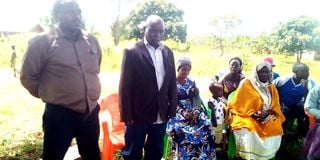Prime
Inside fight for land donated by Museveni

Mr Ereniko Byaruhanga (left) and Mr Eric Kiggundu, some of the beneficiaries of Museveni’s donated land, at a meeting with locals in Kayunga District last week. PHOTO/FRED MUZAALE
What you need to know:
The President bought the land from the late William Buliisa before it was sub-divided among 32 beneficiaries, with each getting 20 acres.
Tension is brewing among the beneficiaries of President Museveni’s land donation in Kayunga District after a section of them claimed they did not get a fair share.
The fighting has attracted the attention of State House officials, among them Ms Judith Oroma, a legal secretary to the President, and Ms Florence Kiconco, the head of the State House legal department.
The two State House officials have so far convened two meetings on the land in a bid to create harmony among the 32 beneficiaries.
In 1997, Mr Museveni bought 664 acres of land in Namizo Village, Kayonza Sub-county, and Kayunga District, where he resettled 32 families from Ntungamo District.
Last week, Ms Oroma convened a meeting of all beneficiaries at Namizo Umea Primary School in an attempt to solve the wrangles.
The meeting was attended by among others Kayunga deputy Resident District Commissioner Peter Mawerere, Kayonza Sub-county chairperson John Muramuzi, and Namizo Village local leaders.
Ms Oroma, during the meeting, explained that when President Museveni bought the land from the late William Buliisa, it was sub-divided among 32 beneficiaries with each getting 20 acres.
Genesis
“However, after the land had been subdivided, Mr Samuel Muhairwoha came up and dragged the beneficiaries to Mukono High Court on charges of illegal possession of his land,’’ Ms Oroma said.
“Mr Muhairwoha claimed he co-owned the land with his father-in-law, the late Buliisa, who reportedly tricked him and sold it to President Museveni without his knowledge. He won the case and the court ordered he gets his share, which was complied with,” he added.
Mr Muhairwoha was later given back 332 acres, leaving the beneficiaries with 332 acres.
This, Ms Oroma said, necessitated carrying out another survey to subdivide the land.
Mr Moses Oundo, a surveyor, was contracted by State House to survey and subdivide the land among the 32 families, whereby each beneficiary received 10 acres.
Ms Oroma, however, noted that two beneficiaries, including Mr Ereniko Byaruhanga and Mr Eric Kiggundu, each received 50 acres since they had bought off land shares from 10 fellow beneficiaries.
Dissatisfied with the share of 10 acres given to them, Mr John Hamanya and others dragged Mr Kiggundu and Mr Byaruhanga to court on charges of land grabbing.
Both Mr Kiggundu and Mr Byaruhanga are the leaders of the 32 beneficiaries.
“You should not fight one another because you are one family. You very well know how you ended up getting 10 acres instead of the original 20 acres,’’ Ms Oroma said during the meeting.
But Mr Hamanya insisted that the President donated to them 20 acres and not 10, which they had received.
More complainants
During the meeting, three relatives of beneficiaries who had passed on also complained that they had not been given their share during the second subdivision of the land.
Ms Oroma also wondered why some of the land beneficiaries had sold it off.
“You should not fight over something you were just given for free,’’ Ms Oroma advised.
Mr John Muramuzi, the chairperson of Kayonza Sub-county, blamed State House for failing to explain to beneficiaries that half of the land had been returned to the rightful owner, Mr Muhairwoha.
Beneficiaries
Out of the 32 beneficiaries, only three have permanently resettled on the land with others renting it out to local farmers who are using it for cultivation of crops.
Some beneficiaries said the President was not aware of the surveying exercise of the land and that they wanted to meet him to raise their issues.




